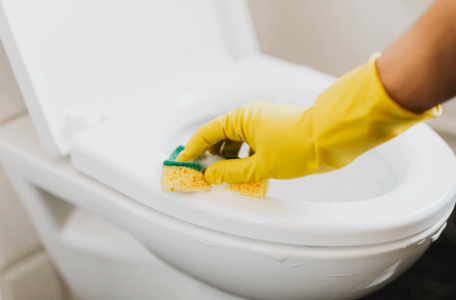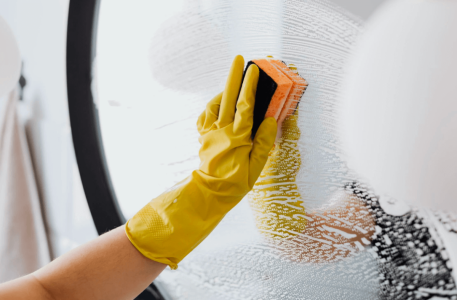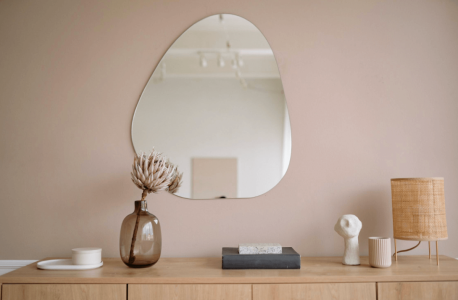Insider tips for cleaning mirrors like a pro!
- Replies 4
Mirrors are the unsung heroes of any home, adding both light and a sense of grandeur to any room. But, they also need regular cleaning.
Unfortunately, cleaning mirrors can be tricky, and many people make common mistakes that can leave them looking dull, cloudy, and streaky.
But don’t worry; a team of professional cleaners has kindly revealed their tips for restoring that sparkle to your mirrors and giving your reflection the shine it deserves.
Whether it's your bathroom mirrors that have lost their shine or your bedroom mirror that's not quite as bright as it used to be, it's time to take some notes and breathe new life into your mirrors!

1. Use a freshly washed cloth to clean your mirrors
It might seem obvious, but the best way to avoid smears, streaks and dirt on your mirrors is to use a clean cloth.
Alicia Sokolowski, president and co-CEO at the eco-friendly cleaning company AspenClean, recommends avoiding any cloths that only look ‘clean’ but haven’t actually been washed recently – if any dust or dirt is left on them from your last clean, they’ll transfer onto your mirror.
2. Never use paper towels
Whenever you need to clean the bathroom mirror, it can be quite tempting to just grab the nearest paper towel and give the mirror a good wipe-down. However, according to Sara San Angelo, professional cleaner and founder of Confessions of a Cleaning Lady, this can do more harm than good!
Paper towels can actually leave lint on your mirror. So instead of using them, opt for a microfibre cloth instead as they are designed to absorb, trap and remove dirt and moisture from the surface. Microfibre cloths are also gentle on the mirror surface and can help protect it from scratches.

3. Avoid using the same sponge
When cleaning mirrors, it is important to use a clean and dedicated tool. Using the same sponge or cloth that you use to clean other surfaces in your bathroom, such as your sink or toilet, can transfer bacteria and grime. This can not only leave your mirrors looking dirty, but it can also pose a health hazard due to the spread of germs and bacteria.
4. Remove grime and dust build-up
If your mirror is in a high-traffic area or is particularly dirty, you’ll need to give it a deep clean first. Add a small amount of washing-up liquid to a microfibre cloth and warm water, then use a squeegee or window vacuum to remove the moisture before polishing with white vinegar or a window and glass cloth.
5. Watch how much cleaner you use
It's important to be mindful of the amount of cleaning product you use on your mirrors. Using excessive amounts is not only costly, but it can also leave behind a residue on the mirror surface, making it appear dull and cloudy. Also, using too much can damage the mirror's surface, making it harder to clean in the future.
To achieve a sparkling clean result, it's best to use a small amount of cleaning product - a few drops or sprays of your preferred cleaning solution will be more than enough!
6. Don’t spray products directly on the mirror
According to Sokolowski, too much cleaning product can be difficult to remove and can result in smears. But it’s better to add the product to the cloth than to spray it directly onto the mirror. This can help you to avoid over-saturating the mirror and save money in the long run.

7. Have an organised cleaning pattern
Cleaning should follow an organised pattern if you want your mirror to shine without streaks. To avoid missing any spots and leaving behind any unwanted streaks, you can try working from the top down and in a 'Z' shape or a sideways pattern.
8. Choose an eco-friendly cleaner
Choose a natural glass cleaner with all the ingredients listed. Many household cleaning products have chemical or toxic products in their ingredients which can be bad for your health and the environment.
9. Finish by buffing
Once the cleaning product has been removed, take a dry cloth and buff your mirror to get the best streak-free shine. Make sure to wipe in a consistent motion when buffing and wipe top to bottom, using small circular motions.

It’s important to keep your mirrors clean and sparkling, but if you’re still having trouble getting that streak-free shine after trying these tips, then it might help to keep in mind that some mirrors may be going through a process called desilvering.
This is most commonly seen on less expensive mirrors and can often cause the mirror’s sheen to become cloudy or leave black spots in the finish.
Mirrors are made by applying a thin layer of metallic silver to the surface of the glass. This silver layer is responsible for the reflective properties of the mirror.
Over time, the silver layer in the mirror can deteriorate. One of the main causes of mirror deterioration is exposure to moisture and humidity. When a mirror is exposed to moisture, the silver layer can begin to tarnish and corrode, causing the mirror to lose its reflective properties.
Exposure to heat can also cause the silver layer to degrade. High temperatures can cause the silver to expand and contract, which can cause the layer to become cracked or damaged.
We hope you’ve found our tips useful, members! Now you’ve learnt some of the do’s and don’ts of cleaning mirrors, why not share this article with your friends and family?
Unfortunately, cleaning mirrors can be tricky, and many people make common mistakes that can leave them looking dull, cloudy, and streaky.
But don’t worry; a team of professional cleaners has kindly revealed their tips for restoring that sparkle to your mirrors and giving your reflection the shine it deserves.
Whether it's your bathroom mirrors that have lost their shine or your bedroom mirror that's not quite as bright as it used to be, it's time to take some notes and breathe new life into your mirrors!

Most people don’t think twice about how best to clean a mirror, and the simple task of getting the perfect shine is easier said than done! Credit: Karolina Grabowska.
1. Use a freshly washed cloth to clean your mirrors
It might seem obvious, but the best way to avoid smears, streaks and dirt on your mirrors is to use a clean cloth.
Alicia Sokolowski, president and co-CEO at the eco-friendly cleaning company AspenClean, recommends avoiding any cloths that only look ‘clean’ but haven’t actually been washed recently – if any dust or dirt is left on them from your last clean, they’ll transfer onto your mirror.
2. Never use paper towels
Whenever you need to clean the bathroom mirror, it can be quite tempting to just grab the nearest paper towel and give the mirror a good wipe-down. However, according to Sara San Angelo, professional cleaner and founder of Confessions of a Cleaning Lady, this can do more harm than good!
Paper towels can actually leave lint on your mirror. So instead of using them, opt for a microfibre cloth instead as they are designed to absorb, trap and remove dirt and moisture from the surface. Microfibre cloths are also gentle on the mirror surface and can help protect it from scratches.

Keep a separate sponge on hand for cleaning mirrors at home rather than using the same one again and over. Credit: Pexels/Karolina Grabowska.
3. Avoid using the same sponge
When cleaning mirrors, it is important to use a clean and dedicated tool. Using the same sponge or cloth that you use to clean other surfaces in your bathroom, such as your sink or toilet, can transfer bacteria and grime. This can not only leave your mirrors looking dirty, but it can also pose a health hazard due to the spread of germs and bacteria.
4. Remove grime and dust build-up
If your mirror is in a high-traffic area or is particularly dirty, you’ll need to give it a deep clean first. Add a small amount of washing-up liquid to a microfibre cloth and warm water, then use a squeegee or window vacuum to remove the moisture before polishing with white vinegar or a window and glass cloth.
5. Watch how much cleaner you use
It's important to be mindful of the amount of cleaning product you use on your mirrors. Using excessive amounts is not only costly, but it can also leave behind a residue on the mirror surface, making it appear dull and cloudy. Also, using too much can damage the mirror's surface, making it harder to clean in the future.
To achieve a sparkling clean result, it's best to use a small amount of cleaning product - a few drops or sprays of your preferred cleaning solution will be more than enough!
6. Don’t spray products directly on the mirror
According to Sokolowski, too much cleaning product can be difficult to remove and can result in smears. But it’s better to add the product to the cloth than to spray it directly onto the mirror. This can help you to avoid over-saturating the mirror and save money in the long run.

The best way to clean mirrors without leaving streaks or lines is to follow an organised cleaning pattern. Credit: Pexels/Karolina Grabowska.
7. Have an organised cleaning pattern
Cleaning should follow an organised pattern if you want your mirror to shine without streaks. To avoid missing any spots and leaving behind any unwanted streaks, you can try working from the top down and in a 'Z' shape or a sideways pattern.
8. Choose an eco-friendly cleaner
Choose a natural glass cleaner with all the ingredients listed. Many household cleaning products have chemical or toxic products in their ingredients which can be bad for your health and the environment.
9. Finish by buffing
Once the cleaning product has been removed, take a dry cloth and buff your mirror to get the best streak-free shine. Make sure to wipe in a consistent motion when buffing and wipe top to bottom, using small circular motions.
Key Takeaways
- Professional cleaners have advised the correct cleaning techniques for mirrors to avoid ruining their shine.
- Some of the most common mistakes are using a dirty cloth, paper towels, and the same sponge used for other areas in the bathroom.
- It is important to use a window and glass cloth, a microfibre cloth, and a natural-based glass cleaner to get a streak-free shine.
This is most commonly seen on less expensive mirrors and can often cause the mirror’s sheen to become cloudy or leave black spots in the finish.
Mirrors are made by applying a thin layer of metallic silver to the surface of the glass. This silver layer is responsible for the reflective properties of the mirror.
Over time, the silver layer in the mirror can deteriorate. One of the main causes of mirror deterioration is exposure to moisture and humidity. When a mirror is exposed to moisture, the silver layer can begin to tarnish and corrode, causing the mirror to lose its reflective properties.
Exposure to heat can also cause the silver layer to degrade. High temperatures can cause the silver to expand and contract, which can cause the layer to become cracked or damaged.
We hope you’ve found our tips useful, members! Now you’ve learnt some of the do’s and don’ts of cleaning mirrors, why not share this article with your friends and family?








